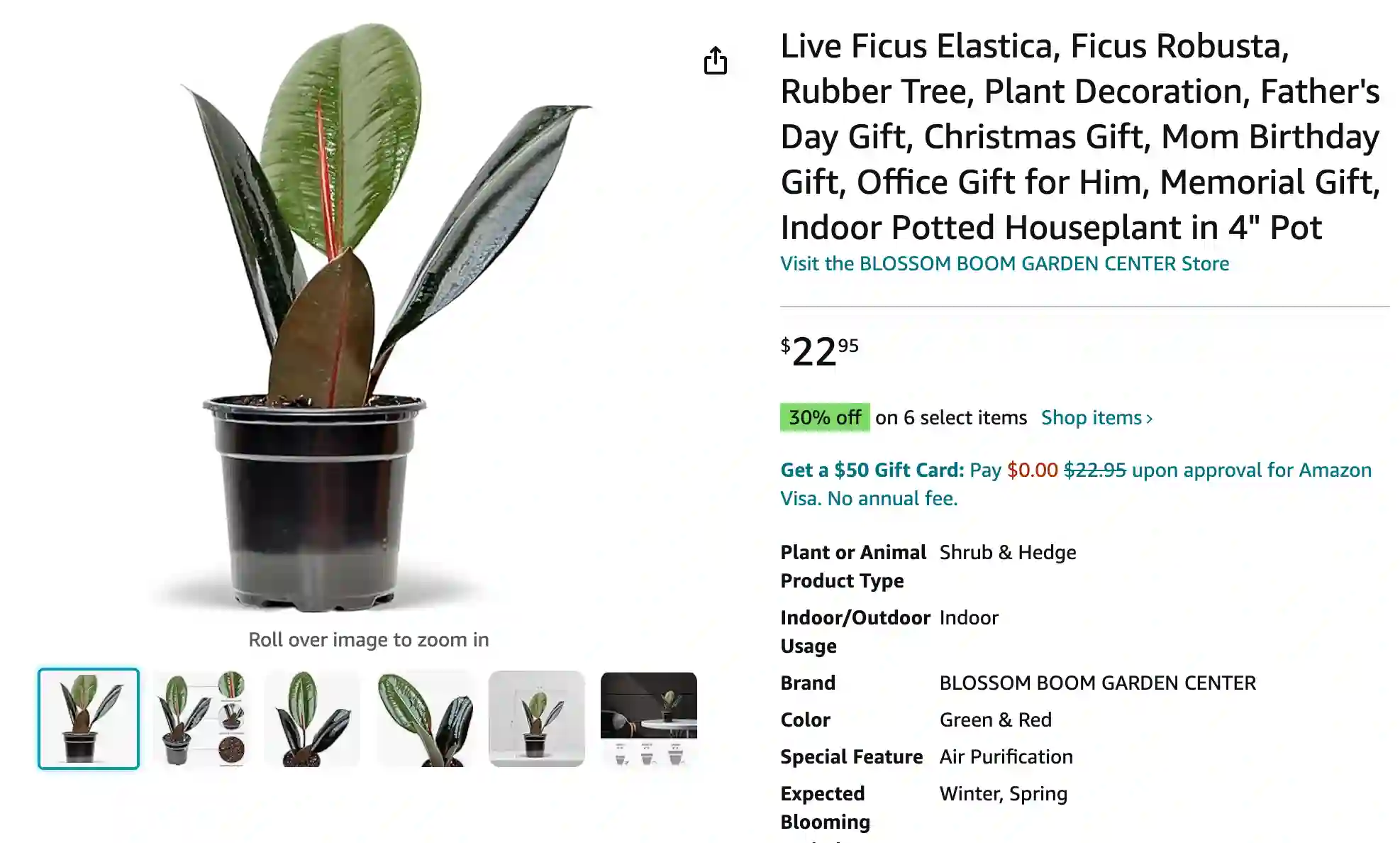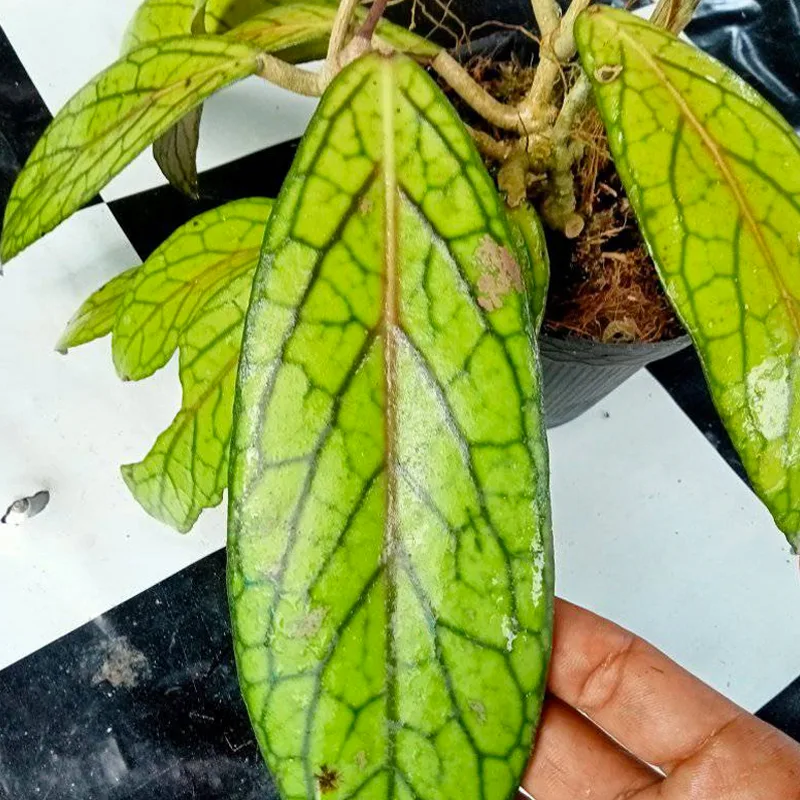
Ficus Elastica Robusta vs Burgundy:
I love the robust, deep green leaves of the Robusta, but the Ficus Elastica Burgundy‘s rich, dark-red foliage adds such a striking contrast in my indoor jungle.
Ficus Elastica Robusta vs Decora:
The Robusta’s large, glossy leaves make it a bold centerpiece, while the Decora’s lighter green and cream variegation adds a softer, more airy feel to my plant collection.
Ficus Abidjan vs Robusta:
While the Robusta is robust indeed, the Abidjan’s unique mottled pattern and smaller leaf size make it a charming addition to any plant shelf, bringing a different texture and vibe to the space.
880 Species in Genus Ficus
How to care for Ficus robusta?
Ficus robusta, also known as the Rubber Tree or Indian Rubber Tree, is a popular houseplant known for its large, glossy leaves. Here’s a guide on how to care for it:
Light:
- Ficus robusta prefers bright, indirect light. Avoid direct sunlight, which can scorch the leaves.
- East or north-facing windows are ideal locations. If placed near a south-facing window, provide some afternoon shade.
Watering:
- Allow the top inch of soil to dry out completely between waterings. Overwatering is a common cause of problems with Ficus robusta.
- When watering, soak the soil thoroughly until water drains out of the drainage holes. Discard any excess water in the saucer to prevent root rot.
Soil:
- Use a well-draining potting mix. A mixture specifically formulated for houseplants is ideal.
- You can also create your own mix using potting soil, perlite, and orchid bark for added drainage.
Temperature and Humidity:
- Ficus robusta thrives in warm temperatures between 60-75°F (15-24°C). Avoid placing it near cold drafts or heating vents.
- While it tolerates average household humidity, it appreciates higher humidity levels. You can increase humidity around the plant using a humidifier, pebble tray, or misting occasionally.
Fertilizing:
- During the growing season (spring and summer), fertilize your Ficus robusta every two weeks with a balanced, water-soluble fertilizer diluted according to package instructions.
- Reduce or withhold fertilizer during the winter months when the plant goes dormant.
Pruning:
- Pruning is not strictly necessary but can be done to control size and shape. Pinch off new growth at the tips to encourage branching and a bushier appearance.
- You can also prune away leggy stems or remove any yellowing or damaged leaves.
- When pruning, use sharp, sterilized pruning shears to avoid damaging the plant.
Additional Tips:
- Repot your Ficus robusta every 1-2 years when it outgrows its current pot. Choose a pot with drainage holes that is slightly larger than the previous one.
- Wipe the leaves occasionally with a damp cloth to remove dust and improve their light-absorbing ability.
- Ficus robusta is generally pest and disease resistant, but watch out for common houseplant pests like mealybugs and scale insects. You can treat them with insecticidal soap or neem oil.
Is Ficus robusta toxic to cats?
When I first brought home my Ficus robusta, I was concerned about its toxicity to my cat. After doing some research, I discovered that while it’s not considered highly toxic, it can cause gastrointestinal upset if ingested. To keep my cat safe, I make sure to place the plant in an area where she can’t reach it, and I keep an eye on her whenever she’s near it. So far, she hasn’t shown much interest in it, but I prefer to err on the side of caution.
How to propagate Ficus robusta?
Propagation of my Ficus robusta has been an exciting experiment for me. I’ve had success with both stem cuttings and air layering. For stem cuttings, I carefully trim a healthy branch and place it in water until roots develop, then transfer it to soil. Air layering involves wrapping a section of the stem in moist sphagnum moss until roots form, then cutting it away from the parent plant and planting it in its own pot. It’s a rewarding process to see new plants grow from cuttings of the original.
How often to water Ficus robusta?
Determining the watering schedule for my Ficus robusta has been a learning process. Initially, I was watering it too frequently, which led to soggy soil and unhappy roots. Now, I’ve established a routine of watering it thoroughly when the top inch of soil feels dry to the touch. This usually translates to watering every 1-2 weeks, but I adjust based on factors like temperature and humidity. It’s all about finding the right balance to keep the plant healthy and happy.
Is Ficus robusta poisonous to dogs?
While researching about Ficus robusta, I also looked into its potential toxicity to dogs. Fortunately, I found that it’s generally not considered harmful to dogs if ingested in small amounts. However, like with cats, I take precautions to ensure my dog doesn’t munch on the leaves. I’ve placed the plant in a spot that’s inaccessible to him, and I supervise him whenever he’s indoors to prevent any curious nibbling.
Where to buy a Ficus elastica robusta?
When I decided to add a Ficus elastica robusta to my plant collection, I wanted to make sure I was getting a healthy specimen from a reputable source. I ultimately opted to purchase mine from a local nursery that specializes in houseplants. I appreciated being able to see the plant in person and choose one that looked robust and well cared for. Plus, the staff was knowledgeable and able to provide me with specific care instructions tailored to my new plant.
If i die, water my plants!
